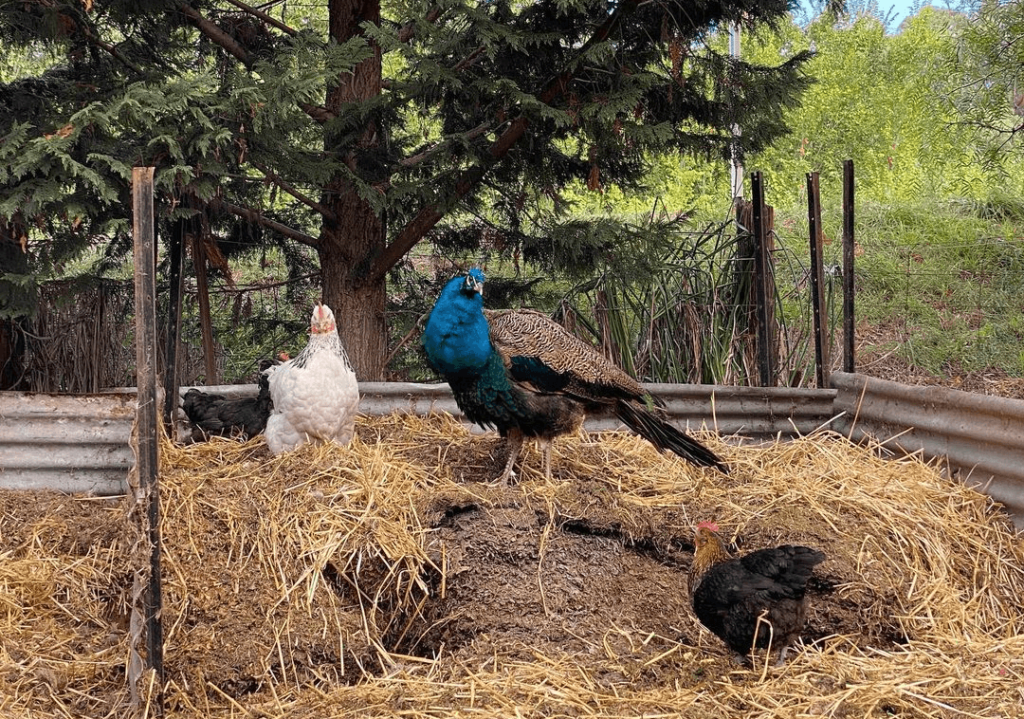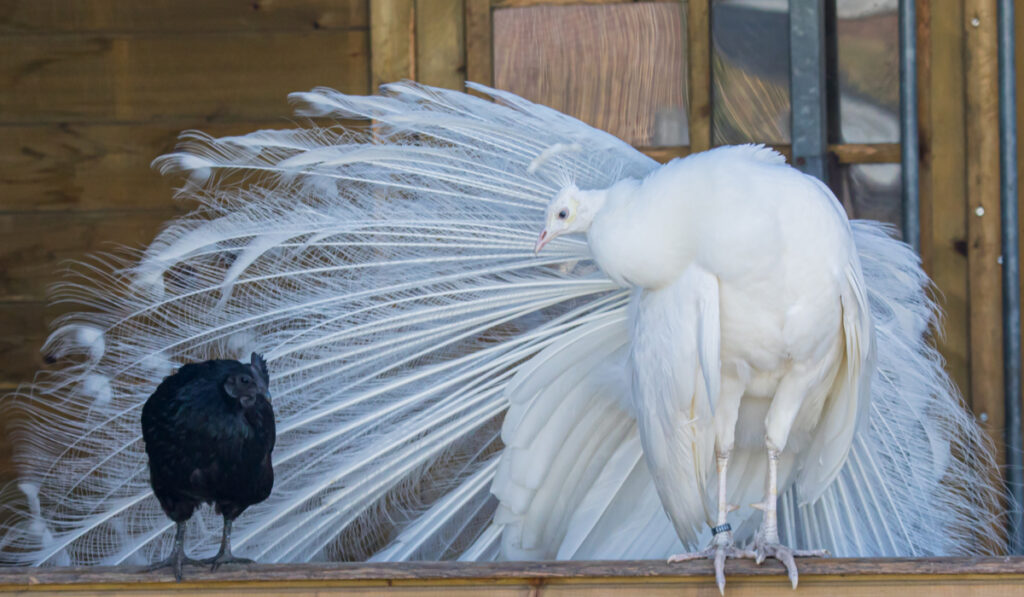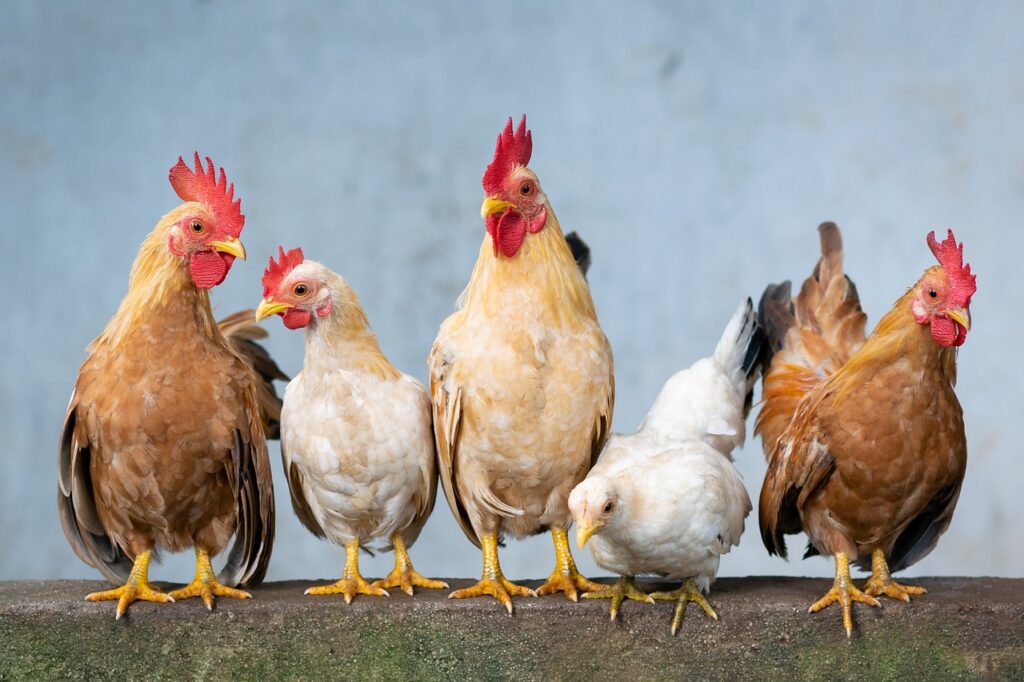Many people who raise chickens in their backyards usually keep multiple species of birds or poultry. Perhaps you’re considering expanding your flock of chickens to include ducks or swans. Or maybe you’ve tried introducing pheasants with some success and are open to trying something different, like peafowl?
There are risks associated with keeping different species of birds in the same backyard. We will review the advantages and disadvantages of adding peacocks and/or peahens to your flock of chickens.

Can Peacocks Live With Chickens?
Yes. While it is conceivable, raising and maintaining chickens and peacocks together is not advised. Peacocks and chickens are distinct animals with differing housing and nutritional needs. Moreover, there is an increased risk of disease transmission between birds when chickens and peafowl are housed together.
The following are the most typical things to consider while housing hens and peacocks together:
- Pecking order
- Feed
- Coop and run size
- Transfer of diseases

Pecking Order
As we all know, many animals thrive best in social situations, while others prefer to live alone. Due to their social nature, both chickens and peafowl require other people’s companionship to remain happy and healthy. While peafowl can be raised in pairs, hens will feel most at home in a larger flock.
As we all know, many animals thrive best in social situations, while others prefer to live alone. Due to their social nature, both chickens and peafowl require other people’s companionship to remain happy and healthy. While peafowl can be raised in pairs, hens will feel most at home in a larger flock.
Introducing new people to your hens’ living quarters will disturb the hierarchy and the flock, particularly if you are interacting with other kinds of animals. Give them time to get used to one another while keeping an eye out for any misbehavior or bullying. Bullying and fighting WILL occur, so try your best to keep things from getting out of control.
Most often, fights happen when there is a:
- Lack in space
- Lack in feed
More room is required for peacocks than for hens, and it is ideal to keep them both free-ranging or in a sizable run. Inadequate room leads to a host of issues, including hostile behavior, harassment, and unclean living conditions. Their respective dietary requirements are also diverse. To prevent them from eating each other’s food, you must keep them apart when they are being fed. Also, provide them with an abundance of food at all times because hunger might make them grumpy.
Feed
Peacocks and chickens are distinct species with differing dietary requirements. More protein should be included in a peacock’s diet because they must develop huge feathers, lay eggs, and build tissue.
It is wasteful to feed your hens the same feed as peacock feed because the latter is more expensive and the former doesn’t require the additional protein. During feeding time, keep the meal locked away and separate the birds. Kitchen scraps can be consumed by peacocks and chickens, although this should only occur sporadically. Never give your birds more snacks than 10% of their daily food intake.
Coop And Run Size
All animals, including people, require their area. Overcrowding can lead to several physical and psychological problems for your birds.
Given that peafowl are larger than average chickens, it is reasonable to house them in a much larger run. A larger coop and higher roosting platforms are important necessities for peacocks. Beware that peacocks can be very loud. They are not the best birds to be kept in a suburban neighborhood, so next to the space issues, there’s also a noise factor to keep in mind when placing peacocks in your backyard.
Run Size
For chickens, a minimum of ten feet is a decent rule of thumb. However, peafowl require a lot more room. A peacock requires a minimum of 80 square feet for its living area. You can let them roam freely, but they will explore every backyard in the neighborhood and go pretty far, unlike your hens. To avoid problems or disputes, always ask your neighbors and the local authority before retaining peafowl on your property.
Installing a fence at least eight feet high is necessary for keeping peafowl in an enclosed pen since they may jump or fly higher than hens.

Coop
A separate roosting area is required for chickens and peafowl, thus housing a peacock or peahen requires extra care.
A coop for chickens should have a space of three to five square feet for each fowl. Position roosting bars between 1.5 and 3 feet above the ground, with approximately 8 inches of roosting bar for each chicken.
While indoor living space is not necessary for peafowl, it is recommended if you wish to protect the birds from predators at night. A minimum of 10 square feet is needed for each bird. The majority of peacocks sleep on their roosting bar, on a tree branch, or inside a fenced corral. It is recommended to position nesting perches at a minimum elevation of 5 feet above the ground.

Transfer Of Diseases
The biggest worry with keeping hens and ducks in the same house is the increased potential for disease transmission. Not all chickens will exhibit symptoms, but it is known that they can transmit diseases and parasites. Whether you’re adding chickens, ducks, pheasants, or peafowl to your flock, make sure you quarantine them in a different pen for at least two weeks before allowing them to join the rest of the flock.
Blackhead Disease, a parasitic poultry disease caused by the protozoan Histomonas meleagridis and spread by cecal worms, is a common illness while keeping chickens and peafowl. The parasite has a significant death rate and attacks the liver and cecum. Reduced appetite, sluggishness, yellow diarrhea, thirst, and ruffled feathers are signs of blackhead sickness. Since there are currently no treatments for Blackhead Disease, stopping its parasitic spread is essential.
The more animals you own, the greater the likelihood of developing health problems. Before reintroducing new birds to the flock, quarantine them for a minimum of two weeks and isolate sick birds right away.
Conclusion
You can keep both hens and peafowl in one building. But there are a lot of considerations. Both require their living place, sleeping area, food, and medical attention because they are extremely distinct animals. It can be difficult to stop the spread of illnesses like blackhead sickness, in particular. However, there are many examples of animal enthusiasts who maintain chickens and peacocks together, so you’ll adore these vibrant birds a lot if you have the time and room to make it work.
